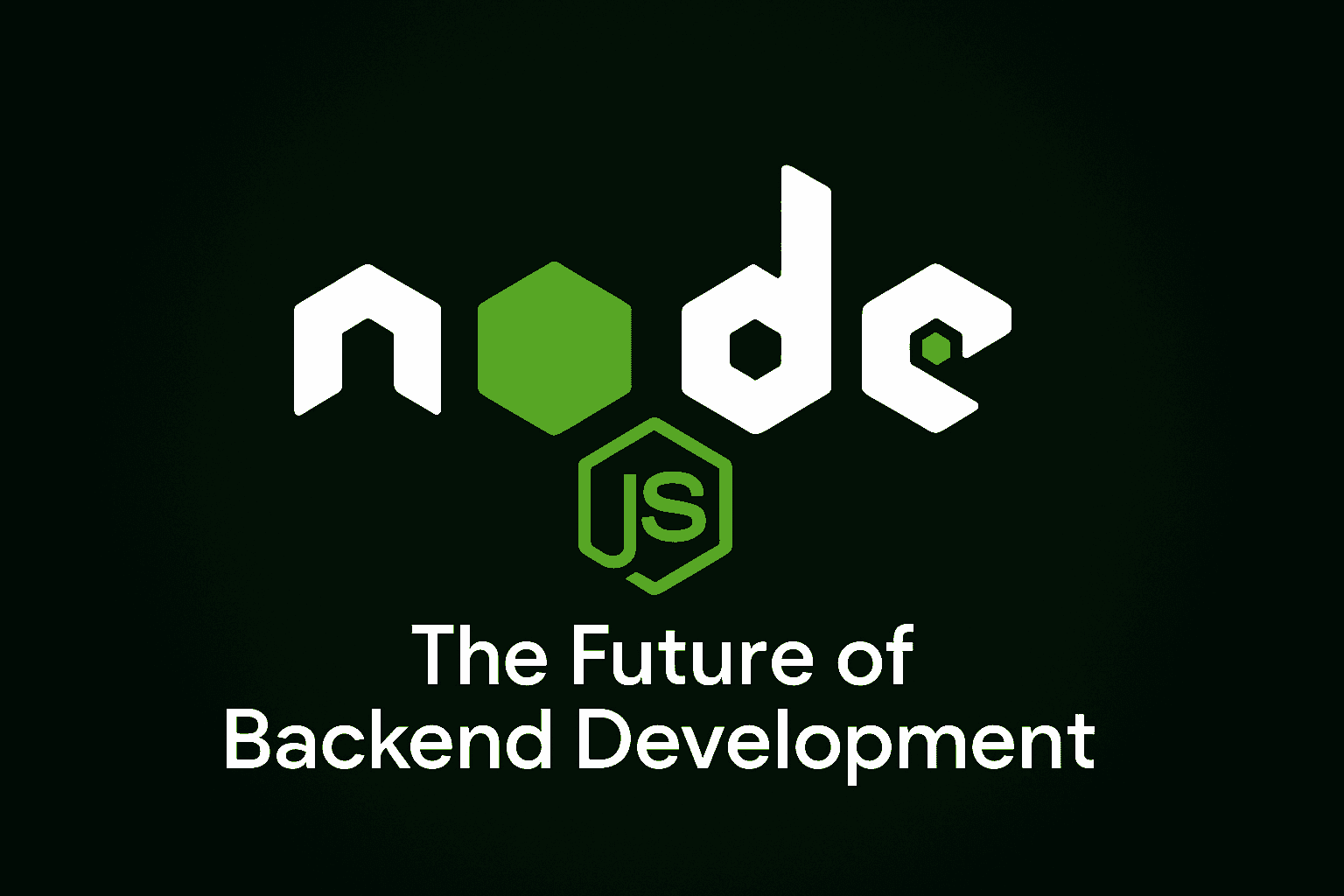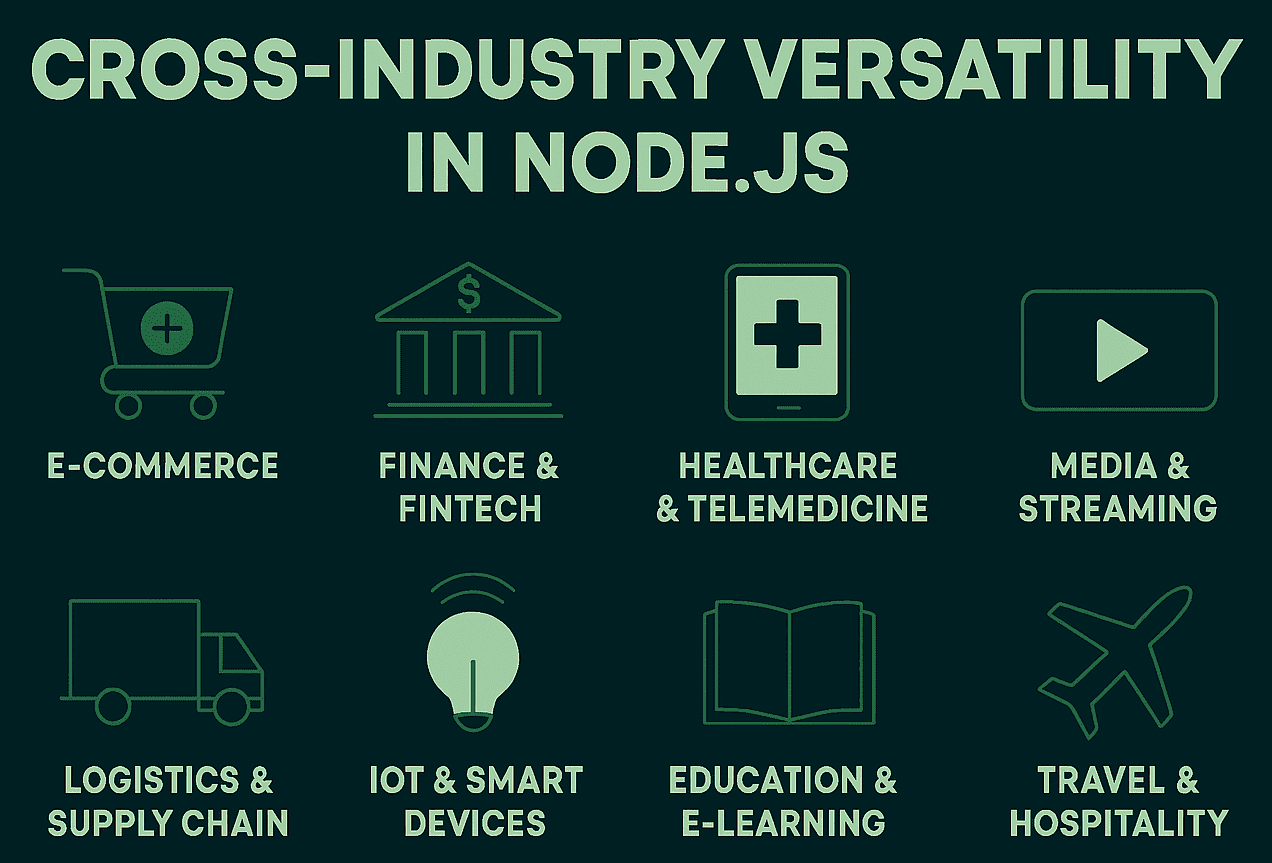The Backend Revolution Starts with Node.js
Node.js has emerged as a vital technology for modern web and mobile applications, efficiently managing data, executing business logic, and ensuring smooth communication between servers, databases, and clients. With the growing demand for digital solutions it provides backend systems that are fast, scalable, and adaptable to evolving needs. By enabling JavaScript across the entire development stack, Node.js simplifies workflows, promotes collaboration between teams, and powers real-time, high-performance applications, while also supporting innovative models such as serverless computing and edge deployment.

Backend Development in the Modern Era with Node.js
✅Optimized for Serverless: Easily integrates with serverless platforms, allowing developers to concentrate on writing code instead of managing infrastructure.
✅Cross-Platform Support: Runs seamlessly on Windows, Linux, macOS, and major cloud environments.
✅Single Language Across Stack: Leverages JavaScript for both frontend and backend, simplifying workflows and speeding up development.
✅Versatile Database Support: Compatible with SQL, NoSQL, and cloud-based databases, meeting varied application requirements.
✅Cost-Effective Development: Minimizes development time, infrastructure expenses, and resource usage.
✅Extensive Ecosystem: Offers thousands of libraries and frameworks through npm, accelerating application building.
✅Optimized Performance: Built on an asynchronous, non-blocking model that manages multiple concurrent requests with ease.
✅Unified Full-Stack Development: By standardizing on a single language, Node.js accelerates development cycles, enhances maintainability, and allows smaller teams to deliver complex applications more efficiently.
✅Smarter Resource Utilization: Modern Node.js versions offer improved memory efficiency, enhanced monitoring tools, and support for threading, resulting in smoother and more predictable application performance.
✅Powerful API Integration: Node.js simplifies building REST and GraphQL APIs, enabling precise data access, reducing redundancy, and offering a smooth development experience for dynamic applications.
✅Instant Data Applications: Thanks to its event-driven, non-blocking I/O architecture, Node.js powers chat platforms, collaboration tools, and live streaming services, delivering fast, responsive experiences for millions of simultaneous users.
Cross-Industry Versatility

One of Node.js’s strongest advantages is its ability to adapt to diverse industries and use cases, making it a truly versatile backend technology. Its flexibility, scalability, and performance allow businesses across various sectors to leverage Node.js for solving unique challenges while maintaining high efficiency and reliability.
- E-Commerce
Node.js has become a top choice for powering e-commerce backends, thanks to its real-time processing capabilities and ability to efficiently handle large volumes of simultaneous users. Its architecture enables businesses to implement advanced features such as instant product updates, live inventory management, dynamic pricing, and highly responsive customer support. - Finance & Fintech
In the fast-paced fintech sector, reliability, speed, and security are paramount. Node.js’s event-driven architecture facilitates rapid transaction processing, while its compatibility with modern security standards ensures sensitive financial data is protected. Payment gateways, banking applications, and trading platforms leverage Node.js for low-latency operations and real-time updates, delivering secure and efficient financial services. - Healthcare & Telemedicine
Healthcare systems require secure, real-time data processing that complies with regulatory standards. Node.js supports scalable backend solutions for handling patient records, telemedicine sessions, appointment scheduling, and analytics. Its lightweight and responsive architecture ensures healthcare providers can offer fast, dependable, and secure services to patients while maintaining compliance. - Media & Streaming
Node.js excels in powering streaming services, online media platforms, and collaborative content tools by enabling real-time communication and content delivery. Its non-blocking I/O structure allows multiple streams and interactive features like live chats or reactions to run concurrently without lag. Media companies can scale globally while maintaining smooth performance and uninterrupted user engagement. - Logistics & Supply Chain
Efficient logistics and supply chain operations require real-time data processing and dynamic management of inventory, fleets, and deliveries. Node.js is ideal for building systems that handle large-scale, concurrent data flows while integrating with IoT devices for live tracking, predictive analytics, and route optimization. This ensures that logistics operations are accurate, efficient, and scalable. - IoT & Smart Devices
Node.js is highly effective for IoT ecosystems, providing real-time processing for data from connected devices. Its lightweight design and low-latency communication capabilities support applications in smart homes, wearable devices, industrial automation, and sensor networks, enabling faster response times and reliable performance at scale. - Education & E-Learning
Online learning platforms rely on Node.js for live lectures, collaborative sessions, interactive quizzes, and discussion forums. Its asynchronous processing allows multiple participants to engage simultaneously without slowdowns, making it perfect for virtual classrooms, online courses, and collaborative study tools. - Travel & Hospitality
Node.js enhances applications in travel, booking, and hospitality by managing real-time availability, dynamic pricing, and personalized user experiences efficiently. Its scalable backend ensures smooth performance even during peak seasons, allowing platforms to handle high traffic volumes without downtime and provide a reliable, engaging experience for users
Node.js as Middleware for Headless Odoo
In an Odoo setup, Node.js can serve as a powerful middleware layer, functioning as a headless gateway between Odoo’s backend and modern frontend applications. Rather than letting frontends interact with Odoo’s APIs directly, Node.js operates as an independent server that consumes these APIs, processes the data, and then delivers it in a streamlined, high-performance, and scalable format.
What is Headless Odoo?
A headless architecture separates the backend (ERP logic, data, workflows) from the frontend (user interface). In this setup:
- Odoo acts as the backend, managing all business operations and data.
- Node.js acts as the middleware, connecting Odoo with modern frontend applications like React, Vue, Angular, or mobile apps.
- Frontend applications interact only with Node.js, not directly with Odoo.
Role of Node.js as Middleware
Node.js serves as a headless API layer between Odoo and frontend applications. Its responsibilities include:
- Proxy Between Frontend and Odoo
- Node.js acts as a bridge, consuming Odoo’s APIs and delivering clean, structured data to frontend clients.
- Providing REST/GraphQL APIs
- While Odoo exposes JSON-RPC or XML-RPC APIs, Node.js can convert them into RESTful or GraphQL endpoints, which are easier to consume for modern frontends.
- Authentication, Caching, and Rate Limiting
- Node.js can handle security and performance optimizations, ensuring fast response times and protecting backend resources.
- Integration Hub
- Node.js can merge Odoo data with external systems such as Shopify, payment gateways, or IoT devices, providing a unified API for all connected applications.
Benefits of Using Node.js Middleware with Odoo
- Scalable Frontends: Node.js handles high-frequency API calls efficiently, reducing load on Odoo.
- Real-Time Capabilities: WebSockets in Node.js enable live notifications, dashboards, and collaborative features.
- Flexible Architecture: Developers can use any frontend framework or mobile platform without being tied to Odoo’s default UI.
- Faster API Responses: Optimized Node.js endpoints improve frontend performance compared to raw Odoo RPC calls.
- Integrated Workflows: Combines data from multiple sources into a single API, simplifying operations and reporting.
Advanced Node.js Backend Techniques
Node.js empowers developers with a versatile ecosystem for designing REST APIs as well as reliable, high-performing, and scalable backend solutions. To master advanced development, engineers must explore its asynchronous model, harness its event-driven core, and apply best practices in architecture, security, and deployment.
Here, we examine the critical elements that take a Node.js app from functional to exceptional.
1. Performance Optimization & Event Loop Mastery
- Non-Blocking I/O & Asynchronous Patterns: Apply non-blocking operations rigorously. Use async/await for clean asynchronous code, but monitor long-running tasks to prevent blocking the event loop.
- Worker Threads: Offload CPU-intensive tasks (e.g., image processing, complex computations) to Worker Threads to keep the main loop responsive.
- Stream API: Process large datasets efficiently with readable, writable, and transform streams for file uploads, data exports, and real-time processing.
- Caching Strategies:
- In-Memory Caching: Fast access to frequently used, short-lived data.
- Distributed Caching (Redis, Memcached): Scalable across multiple instances.
- CDN Caching: Optimize static assets and edge delivery.
- In-Memory Caching: Fast access to frequently used, short-lived data.
- Database Optimization: Use indexing, connection pooling, and query optimization to improve performance.
- Profiling & Benchmarking: Identify bottlenecks using tools like perf_hooks, Clinic.js, or Autocannon.
2. Scalability & Resilience
- Microservices Architecture: Break monolithic apps into smaller, independent services for modularity and independent scaling.
- Communication Patterns: Choose appropriate inter-service communication methods (REST, gRPC, message queues like RabbitMQ or Kafka).
- API Gateway: Manage requests, authentication, rate limiting, and routing to microservices.
- Load Balancing & Reverse Proxies: Distribute traffic across instances with tools like Nginx or HAProxy; use sticky sessions if required.
- Containerization & Orchestration: Package apps with Docker and manage deployments with Kubernetes.
- Fault Tolerance: Implement graceful shutdowns, circuit breakers, retry mechanisms, dead letter queues, and message queues for reliability and asynchronous processing.
3. Security Best Practices
- Authentication & Authorization: Use JWT, OAuth 2.0, OpenID Connect, and RBAC for secure access control.
- Input Validation & Sanitization: Prevent SQL/NoSQL injection and XSS using libraries like Joi or Yup.
- Rate Limiting: Protect APIs from DDoS, abuse, and brute-force attacks.
- Secure Configuration Management: Store sensitive data securely with environment variables or secret managers like AWS Secrets Manager.
- Dependency Security: Audit dependencies with npm audit or Snyk.
- HTTPS & CORS: Enforce HTTPS and configure CORS to control resource access.
4. Maintainability & Developer Experience
- Advanced Testing: Include unit, integration, end-to-end (E2E), and performance tests (e.g., using k6).
- Code Quality: Use linters (ESLint), formatters (Prettier), and adopt TypeScript for type safety and maintainability.
- Documentation: Generate interactive API docs with OpenAPI/Swagger for team clarity.
- Repository Strategies: Choose between monorepos and polyrepos based on project scale and modularity.
5. Real-Time & Event-Driven Architectures
- WebSockets (Socket.IO): Enable bidirectional communication for chat, live dashboards, and gaming.
- Server-Sent Events (SSE): One-way event streaming for live updates and notifications.
- Event Sourcing & CQRS: Optimize read/write operations and maintain historical data for complex applications.
5. Serverless & Edge Computing
- Serverless Functions: Deploy Node.js code on AWS Lambda, Google Cloud Functions, or Azure Functions for automatic scaling and pay-per-use execution.
- Edge Computing: Run Node.js at the network edge with solutions like Cloudflare Workers or AWS Lambda@Edge for reduced latency and faster global response times.
Why Businesses Are Choosing Node.js

✔️Customizable Workflows: Easily integrates with existing tools, APIs, and third-party services.
✔️Fast Prototyping: Enables developers to quickly design, build, and test new features or products.
✔️IoT Integration: Efficiently manages real-time data streams from connected devices and IoT systems.
Real-Time Functionality: Ideal for chat applications, online gaming, live streaming, and collaborative platforms.
✔️Open-Source Ecosystem: Free to use, regularly updated, and widely supported across various industries.
✔️Lightweight & Efficient: Low resource consumption reduces server load and improves performance.
✔️Cloud-Ready Architecture: Designed for seamless deployment in cloud environments and integration with modern DevOps workflows.
Conclusion
As technology continues to advance at an unprecedented rate, both businesses and developers are looking for solutions that combine speed, scalability, and innovation. Over the past decade, Node.js has emerged not merely as a development tool but as a transformative force redefining backend architecture. To understand why Node.js is shaping the future of software development, it is essential to examine its distinctive advantages, its alignment with modern technological demands, and its pivotal role in enabling the next generation of digital solutions.


Leave A Comment